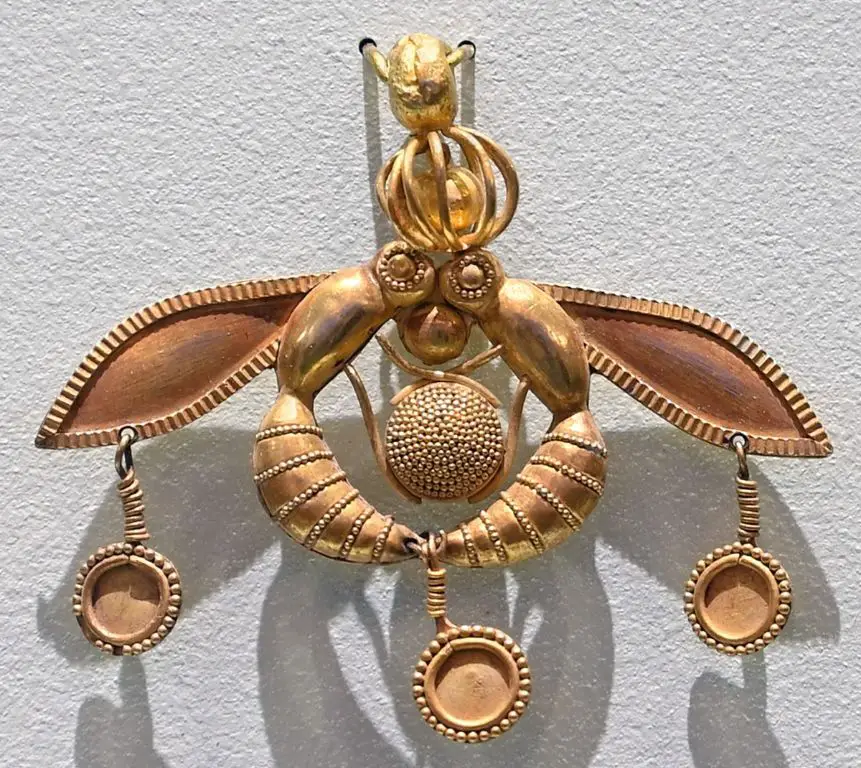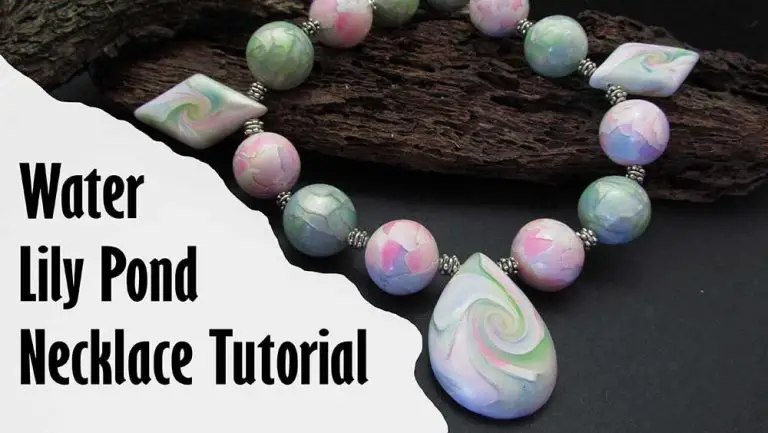What Is The Famous Bee Pendant?
The famous bee pendant refers to an ancient Minoan gold pendant discovered in Crete depicting two bees holding a drop of honey on their wings. It dates back to around 1700 BC and was found in East Crete at the Bronze Age site of Malia, from which it gets its common name as the “Malia Pendant” or “Bees of Malia.” This intricate gold pendant featuring bees is one of the most iconic and celebrated artifacts from Bronze Age Minoan civilization. It demonstrates the advanced goldsmithing techniques of the Minoans and their reverence for bees and nature. The realism and delicate craftsmanship of the bees pendant reflects the artistry of Minoan jewelry makers during the Protopalatial period. The pendant’s discovery provides insight into Minoan culture, beliefs, and jewelry traditions. Today the Malia bees pendant is displayed in the Heraklion Archaeological Museum in Crete as a highlight of Minoan artifacts and continues to be admired for its detailed beauty.
Origins & Creation
The famous bee pendant was created in the mid-1800s by French jeweler Jean-Baptiste Moët. Moët was known for his nature-inspired jewelry and had a particular fondness for bees. As the founder of the Moët & Chandon champagne house, bees held special meaning for him since they pollinate the grapes used to make champagne.
Moët designed the bee pendant to celebrate both his love of bees and the success of his champagne business. The bee became a symbol of hard work, community, and sweet success. He intended for the pendant to capture the essence of these values that he associated with bees and champagne production.
The inspiration for the bee design came directly from Moët’s own vineyards and production facilities. He observed bees pollinating his grapevines and was fascinated by their social structures and productivity. Moët aimed to encapsulate the energy and symbolism of the bee into a wearable work of art.
Materials & Design
The bee pendant is designed in the Art Nouveau style and is crafted out of gold and enamel. The body of the bee consists of gold cells embellished with enamel of various colors including yellow, black, white, blue and red. The cells are assembled using the technique of guilloché enameling which involves applying translucent enamel over an engraved gold background to give a shimmering visual effect. The bee itself has an elongated oval body with transparent enamel wings attached to the sides. It has 6 legs, faceted blue sapphire eyes and black stripes. The bee’s stinger is also visible and rendered in gold.
The pendant measures approximately 3 inches long by 2 inches wide. The bee motif was intended to appear lifelike yet stylized with an elegant, flowing Art Nouveau aesthetic. The range of materials used including enamel, gold and gemstones demonstrates the highest level of luxury jewelry craftsmanship of the era. Every surface is richly decorated with enamel patterns and gold accents in an asymmetric, organic style that was radical and modern when it was created.
Meaning & Symbolism

The bee pendant carries deep symbolic meaning. Bees have long been seen as a symbol of fertility, community, and productivity. The ancient Minoans associated the bee with their Mother Goddess, representing the idea of mutual support, fertility, and sweetness of life (Source). Priestesses of the Greek Goddess were even called “melissae,” meaning bees.
Because bees work cooperatively and industriously, bees also came to symbolize hard work, wealth, abundance and good luck (Source). The bee pendant embraces these rich symbolic meanings, representing the sweetness of life, prosperity, community, and dedication to purpose. Wearing the bee paidant indicates a connection to the ancient reverence for the bee as a vital, sacred creature.
Historical Significance
The Malia Pendant gained fame and significance after its discovery in 1930 during excavations at the Minoan site of Malia on the island of Crete in Greece. It was found in a tomb dating back to 1800-1650 BC, during the height of Minoan civilization. The pendant is believed to have belonged to a prominent woman in Minoan society.
The pendant stands out for its intricate goldwork featuring two bees holding a honeycomb. Bees and honey were incredibly important in Minoan culture, symbolizing fertility, feminine power, and status. The fine craftsmanship of the bees indicates the pendant’s owner was someone of high rank.
After its discovery, the Malia Pendant quickly became one of the most celebrated artifacts from ancient Crete, gaining recognition as a stunning example of Minoan jewelry and artistry. It has been displayed at the Heraklion Archaeological Museum since the 1930s, where it continues to be one of the most popular exhibits for its cultural and historical importance. The pendant provides insight into Minoan jewelry techniques, religious beliefs, and social hierarchy.
Cultural Influence
The iconic Malia bee pendant has had a significant influence on culture throughout history and into modern times. References to the pendant can be seen across various art forms and literature. For example, the bees depicted in ancient Minoan frescoes are believed to be inspired by the famous pendant’s honeybee design (Greece Is, 2021). Many artists have reproduced images of the pendant or created their own artistic interpretations of it. The pendant is also frequently referenced in books and poetry about ancient civilizations and jewelry.
In film, the Malia bee pendant has appeared in movies focused on the Minoan civilization, being worn by actresses portraying ancient priestesses and goddesses. The symbolic importance of bees in Minoan culture, as represented by the pendant, is a common motif in these films. Additionally, replica pendants inspired by the original are popular in jewelry design. The honeybee motif continues to be frequently incorporated into necklaces and earrings.
Overall, the discovery of the intricate gold bee pendant at Malia opened the door for many creative works across culture. As an iconic symbol of an ancient civilization, it has decorated art galleries and inspired cinematic costumes. Its legacy is a testament to the sophisticated artistry of Minoan goldsmiths whose work continues to dazzle centuries later.
Modern Day Importance
The famous bee pendant remains a significant and iconic piece of jewelry even today. Here are some of the key reasons it continues to be cherished and valued in modern times:
It is still seen as a symbol of royalty and prestige. While no longer restricted to actual royalty, owning an original or high-quality replica bee pendant conveys a sense of sophistication, wealth, and refined taste.
The pendant’s unique and intricate craftsmanship is still admired today. Its delicate goldwork and detailed honeycomb design serve as inspiration for modern jewelry makers looking to create their own bee-themed pieces.
The bee remains a popular symbol today. Its connotations of community, productivity, and environmentalism resonate with modern values. The pendant allows the wearer to celebrate these meanings through their jewelry.
It retains its status as a conversation starter. The pendant’s storied history and beautiful appearance make it a distinctive accessory that draws attention and curiosity.
Owning an original or possession of one in the family is seen as prestigious. The pendant is associated with fame, power, and important historical figures, making ownership something to take pride in.
It continues to feature heavily in films, TV shows, and other media as an iconic piece of jewelry.
Notable Owners
The famous bee pendant has been worn by many celebrities and notable figures over the years. Some of the most famous owners of the bee necklace include:
The Duchess of Sussex, Meghan Markle, was gifted a gold bee necklace by the designer Carolyn Tracey when visiting Cardiff in 2018. She wore it during her first joint royal engagement with Prince Harry (Alex Monroe). This helped spur interest in the bee pendant.
The Duchess of Cambridge, Kate Middleton, also owns the famous bee pendant. She was photographed wearing an affordable high street version in gold with three bees (Alex Monroe). This increased its popularity.
Other celebrity owners include Florence Welch, Alexa Chung, Fearne Cotton and more. The pendant has become a staple accessory among British influencers and public figures (Alex Monroe).
The bee necklace has also been gifted to First Ladies. Michelle Obama received a gold vermeil version of the famous bee pendant from the UK Prime Minister’s wife Samantha Cameron on a visit in 2011 (Alex Monroe).
Imitations & Replicas
The famous bee pendant has been widely replicated and imitated over the years. As an iconic and instantly recognizable jewelry piece, many jewelers and designers have created their own versions to capture some of its magic and appeal.
Costume jewelry makers started producing affordable plastic and metal versions in the early 1900s to allow more people to wear this fashionable symbol. These mass-produced replicas made the bee pendant accessible beyond the wealthy elite. While lacking in precious materials, they retained the pendant’s distinctive shape and design.
Later in the century, high-end jewelers like Cartier introduced luxury reinterpretations of the original bee pendant. Using gold and diamonds, these jewelers added their own twist while staying true to the pendant’s roots. Their clients were attracted to the bee as a classic and exclusive jewelry statement.
Even major brands like Gucci have riffed on the iconic bee motif. In the 1970s, Gucci debuted its own bee pendant made of gold and colored enamel. It became a signature of the brand, appearing on many of its handbags and accessories. While not an exact replica, it demonstrated the bee pendant’s cultural relevance.
Today there is a thriving market for vintage and antique bee pendants. But quality replicas also remain popular for their elegance and symbolism. The pendant continues to inspire new interpretations by jewelers around the world.
Conclusion
The famous Minoan bee pendant from Malia is an exquisite example of the advanced metalworking skills and artistic talents of the Bronze Age Minoan civilization. Dating back over 3,500 years, the detailed pendant depicts two golden bees hovering over a honeycomb in a remarkably realistic and lifelike manner.
This ancient piece of jewelry provides insight into the cultural and religious beliefs of the Minoans, for whom the bee symbolized divine femininity and an association with mother goddesses. The bees were believed to bridge the natural world and the realm of the gods. The pendant’s delicate yet masterful construction reflects the sophistication of Minoan society.
Today, the bee pendant stands as one of the most iconic and celebrated artifacts recovered from Bronze Age Crete. Its influence can be seen in modern jewelry designs and in enduring maternal and ecological symbolism. This legendary piece of Minoan handicraft represents an important part of our shared human history and serves as a striking example of skill and creativity spanning millennia.





